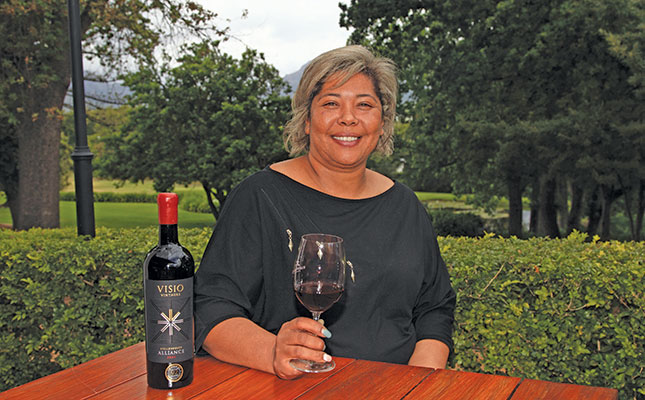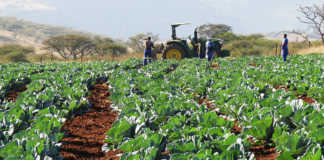
Photo: Glenneis Kriel
The workers on Kleine Zalze wine estate near Stellenbosch in the Western Cape had often heard stories of other farmworkers across South Africa who had benefitted from empowerment initiatives over the past two decades. However, they never thought such an opportunity would ever come their way.
Gerald Snyman, vineyard manager at Kleine Zalze, says that while he dreamt about it, he didn’t think it was possible; and Alicia Alves, general manager of stock control on the farm, says the thought never crossed her mind.
But in 2017, Kobus Basson, then owner of Kleine Zalze, made his employees’ dream a reality when he negotiated a long-term lease agreement for 20ha of municipal land bordering the farm, and entered into a partnership with his staff.
A year later, the Kleine Zalze Empowerment Trust was established and, through its collaboration with the estate, the black-owned Visio Vintners company was formed that same year.
According to Alves, Basson initiated the project because “he wanted to give something back to his workers for their contribution to his success”.
The model
As it is with many other broad-based black economic empowerment (B-BBEE) projects in the agriculture sector, the empowerment trust owns a 51% stake in Visio Vintners, while the estate owns the remaining 49%.
The beneficiaries of the trust don’t hold direct shares in Visio Vintners, which eliminates the problem of what happens to the shares when people wish to sell them, or they leave their jobs at Kleine Zalze or pass away.
Alves explains that all of Kleine Zalze’s permanent workers, whether they joined the labour force before or after the initiative was launched, will share in Visio Vintners’ profits for as long as they work for the estate. The benefit is lost when somebody leaves the company, unless that person has retired or become disabled, in which case he or she continues to receive the benefit for another five years. At the time of writing, Kleine Zalze had about 80 permanent employees.
On the same page
Brandon Uitlander, who is in charge of general maintenance at Kleine Zalze, says everybody knew from the start that the initiative wasn’t a “get-rich-quick [scheme]”.
“Everybody understands that it takes up to four years from planting before vineyards bear commercial yields, and that the winemaking process can add another two years to that.
“We knew it wasn’t going to be an easy ride and that it wasn’t a way to simply make [Kleine Zalze] look good by ticking B-BBEE boxes. The future of Visio Vintners lies in our hands,” he explains.
Before any profit-sharing can take place, the empowerment trust has to repay a R3,5 million loan, which formed its contribution to the establishment and maintenance of the vineyards, as well as the winemaking, bottling, logistics and marketing costs.
“Basson lent us this money, interest-free. Having to repay the loan is actually empowering in itself, as you realise that you don’t work for instant material compensation, but that as business owners we have to be patient and ride out the early cycles of costs and effort before we can move into the black and show a profit,” says Uitlander.
While there haven’t been any major conflicts as yet, the project has seen a few “changes”, with the biggest being the sale of Kleine Zalze to the French wine group AdVini in September this year.
“Good communication with the beneficiaries and the transparency in how things are done are ensuring a smooth transition during these times,” he adds.
AdVini has also been very supportive of the Visio Vintners initiative. “I’ve had wonderful discussions with Antoine Leccia, AdVini’s president, and he is following the project with great interest because of its uniqueness; you won’t find anything like it anywhere else in the world.
“I think AdVini would like to replicate the initiative on some of its other farms once the model has proved itself,” explains Uitlander.
Planting and management
With 15ha reserved for planting, Basson kicked off the project by planting its first vineyards in 2017.
“When I saw the land that had been set aside for us, I knew this was a serious project, as the site had become renowned for producing high-quality red wines from the vines that were planted there before,” says Snyman.
Thus, their primary focus is the red varietals Cabernet Sauvignon, Cabernet Franc and Shiraz. The remainder of the 15ha were planted this year.
The first vineyards were planted on a vertical-shoot trellis system, while those planted this year were done so via a vine-by-post system, which essentially involves trellising a bush vine onto a single pole. The latter vineyards are also unique in that they were planted to a field blend of Syrah.
Their choice of trellis system is determined by the style of wine they want to make, says Snyman.
The vineyard rows are planted in a north-south orientation, which means the entire canopy receives more light than it would if the rows were planted in an east-west direction. This, in turn, helps to evenly ripen the grapes and leads to more uniform fruit.
Cover crops are planted between the vineyard rows, and alternate between triticale and oats, and barley and lupines. “The cover crops help to improve the soil, create a favourable ecosystem, and buffer soil temperatures against extreme cold and heat,” explains Snyman.
Contract workers are employed to do the big tasks in the vineyards, such as pruning and harvesting.
Snyman, however, says he would prefer if the empowerment trust beneficiaries could do more of the work in their vineyards themselves, as this would help to reduce costs.
“I guess this isn’t a practical solution, though, as the beneficiaries are employed in different areas of the Kleine Zalze business, so most of them don’t know how to work the vineyards.”
Alves adds that putting in extra time and effort to make the Visio Vintners brand successful, be it in the vineyard, the winemaking process, logistics or marketing, doesn’t feel like work at all, because it is something they are doing for their own benefit: “This is our baby, so we are willing to go out of our way to ‘raise’ it to become a legacy.”
Nonetheless, while owning your own vineyard and wine brand is rewarding, it also comes with a certain amount of worry, Snyman says.
“I sometimes have sleepless nights because of the vineyard. And now, since the rain has been untimely and we have received so little of it, the risk of poor fruit set is high,” he explains.
The wine
The first wines under the Visio Vintners label were released earlier this year. The range comprises a Sauvignon Blanc, a Pinotage, a Cinsault rosé, a premium red blend called Alliance, and a perlé sparkling wine.
Cellar manager Norman Paulse, who works alongside cellarmaster RJ Botha, says that while the true art of winemaking starts in the cellar, it does require food-quality grapes: “You cannot make something brilliant from inferior raw materials.”
So far this year, says Alves, Visio Vintners has produced roughly 40 000 bottles of wine, which have been sold locally and internationally, and 55 000, 200mℓ cans of the sparkling wine, most of which were exported to Scandinavia.
Their first export order was from Norway for a container of Sauvignon Blanc. Visio is also set to supply Hatch Mansfield, a UK premium wine specialist, which is planning to place its first order for shipment in early January 2023. The aim is to establish the brand in restaurants and independent retail stores in the UK from March next year.
Alves says that while Visio doesn’t want to compete with Kleine Zalze directly, it helps to tap into the latter’s network of distributors, which includes Hatch.
“In South Africa, Vinimark will sell and distribute Visio Vintners from March, too, and AdVini’s distribution network promises to open up new markets for us.”
Main aim
She says their biggest goal now is to perfect the quality of Visio’s wine. And they seem to be doing just that, considering that their Alliance 2020, a blend of Cabernet Sauvignon, Cabernet Franc, Shiraz and Pinotage, scored a commendable 92 out of 100 points in UK wine writer and Master of Wine Tim Atkin’s South Africa 2022 Special Report.
What’s more, their 2020 Pinotage won gold at the Michelangelo International Wine & Spirits Awards.
“Owing to the millions of other brands around the world that we have to compete with, we know that wine quality will be the biggest driver of our project’s success. That’s why we trust Botha to advise us and lead our winemaking,” says Alves.
They are also working on building and marketing the Visio brand, which they started doing at the CapeWine 2022 exhibition in October.
Once they have established distribution networks in core markets, demand for their product will grow and the trust will be able to repay its debt to Basson. They are also considering appointing a dedicated winemaker to take the brand to a next level.
Email Carina Gous at [email protected].










